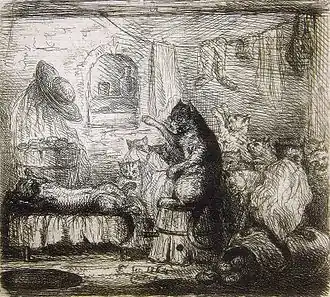The Life and Opinions of the Tomcat Murr
The Life and Opinions of the Tomcat Murr together with a fragmentary Biography of Kapellmeister Johannes Kreisler on Random Sheets of Waste Paper is a complex satirical novel by Prussian Romantic-era author E. T. A. Hoffmann. It was first published in 1819–1821 as Lebens-Ansichten des Katers Murr nebst fragmentarischer Biographie des Kapellmeisters Johannes Kreisler in zufälligen Makulaturblättern, in two volumes. A planned third volume was never completed.[1] It was Hoffmann's final novel and is considered his masterpiece. It reflected his concepts of aesthetics, and predated post-modern literary techniques in its unusual structure. Critic Alex Ross writes of the novel, "If the phantasmagoric 'Kater Murr' were published tomorrow as the work of a young Brooklyn hipster, it might be hailed as a tour de force of postmodern fiction."[2]


An English translation by Anthea Bell was published in 1999 by Penguin Classics.[lower-alpha 1]
Jeffrey Ford described the novel as a "complex, truly wild fiction" where Hoffmann "pieced together the fragments of his own shattered psyche and commented on the relationship of art and artists to society."[3]
Footnotes
- The title of the translation is reminiscent of The Life and Opinions of Tristram Shandy, Gentleman (1759–1767), the experimental novel by British writer Laurence Sterne.
References
- Hoffmeister, Gerhart (2006-10-15). "Kater Murr". The Literary Encyclopedia. Retrieved 2009-09-08.
- Ross, Alex (2009-08-24). "Imaginary Concerts: The Music of Fictional Composers". The New Yorker: 72.
- "Curiosities, F&SF, April 1999